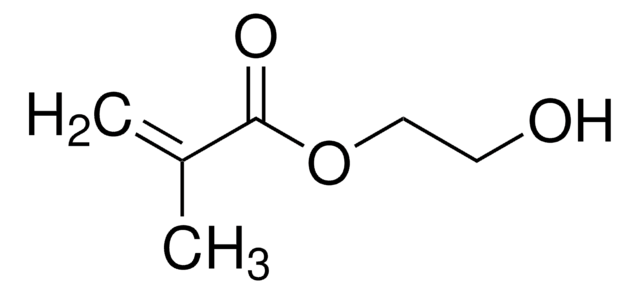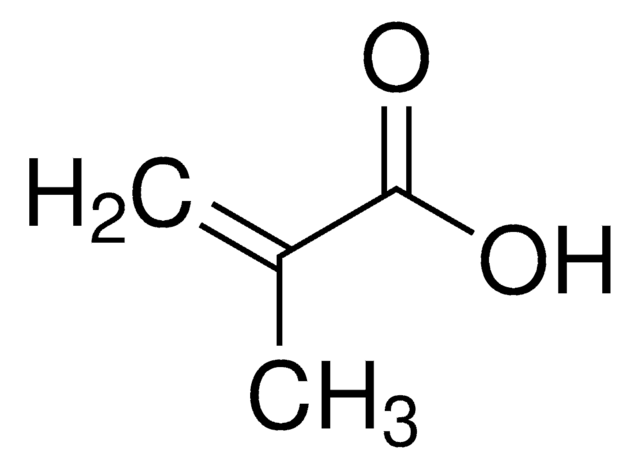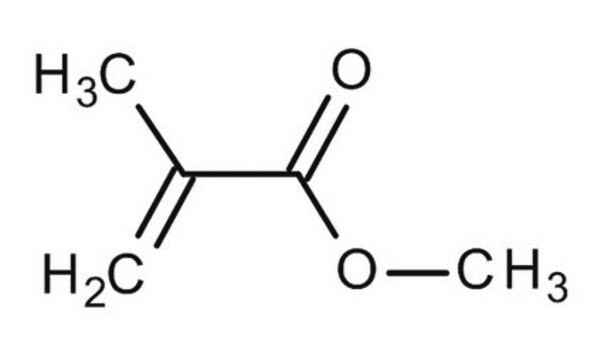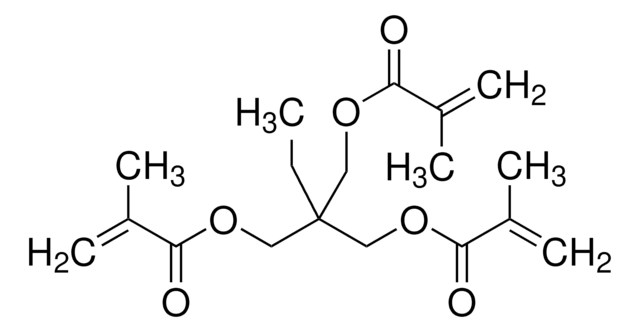8.18847
Ethylene glycol dimethacrylate
(stabilised with hydroquinone monomethyl ether) for synthesis
Synonim(y):
Ethylene glycol dimethacrylate, Ethylene dimethacrylate, Polyethylene glycol
About This Item
Polecane produkty
ciśnienie pary
<1 hPa ( 20 °C)
Poziom jakości
Próba
≥97.5% (GC)
Postać
liquid
siła działania
3300 mg/kg LD50, oral (Rat)
tw
240 °C/1013 hPa
mp
-20 °C
temp. przejścia
flash point 101.5 °C
gęstość
1.05 g/cm3 at 20 °C
temp. przechowywania
2-30°C
InChI
1S/C10H14O4/c1-7(2)9(11)13-5-6-14-10(12)8(3)4/h1,3,5-6H2,2,4H3
Klucz InChI
STVZJERGLQHEKB-UHFFFAOYSA-N
Zastosowanie
- Development of antioxidant and antimicrobial membranes: A study demonstrated the use of ethylene glycol dimethacrylate in the crosslinking of chitosan to develop membranes with antioxidant and antimicrobial properties for tissue regeneration (Ciarlantini et al., 2024).
- Improving hydrogel properties: Research highlighted the benefits of incorporating ethylene glycol dimethacrylate in NVCL-NIPAm hydrogels, enhancing swelling behaviors and mechanical properties for biomedical applications (Tie et al., 2024).
- Synthesis of high-performance polymers: Ethylene glycol dimethacrylate was utilized to fabricate surface molecularly imprinted polymer membranes for the selective separation and extraction of pharmaceutical compounds, showcasing its role in high-performance polymer synthesis (Zhao et al., 2024).
- Dual-functional polymer applications: A study reported on the use of ethylene glycol dimethacrylate in the development of dual-functional molecularly imprinted polymers integrated with carbon dots for detecting and adsorbing contaminants in food, demonstrating its versatility in environmental and food safety applications (Wang et al., 2024).
- Advanced sensing materials: The crosslinking properties of ethylene glycol dimethacrylate were explored in the development of a quartz crystal microbalance sensor, improving its application in food analysis and showcasing its effectiveness in sensor technology (Demir et al., 2024).
Komentarz do analizy
Density (d 20 °C/ 4 °C): 1.048 - 1.051
Identity (IR): passes test
The material is stabilised with hydroquinone monomethyl ether.
At time of analytical testing a content of >10 ppm stabiliser was determined.
Hasło ostrzegawcze
Warning
Zwroty wskazujące rodzaj zagrożenia
Zwroty wskazujące środki ostrożności
Klasyfikacja zagrożeń
Skin Sens. 1 - STOT SE 3
Organy docelowe
Respiratory system
Kod klasy składowania
10 - Combustible liquids
Klasa zagrożenia wodnego (WGK)
WGK 1
Temperatura zapłonu (°F)
219.2 °F - Pensky-Martens closed cup
Temperatura zapłonu (°C)
104 °C - Pensky-Martens closed cup
Certyfikaty analizy (CoA)
Poszukaj Certyfikaty analizy (CoA), wpisując numer partii/serii produktów. Numery serii i partii można znaleźć na etykiecie produktu po słowach „seria” lub „partia”.
Masz już ten produkt?
Dokumenty związane z niedawno zakupionymi produktami zostały zamieszczone w Bibliotece dokumentów.
Klienci oglądali również te produkty
Nasz zespół naukowców ma doświadczenie we wszystkich obszarach badań, w tym w naukach przyrodniczych, materiałoznawstwie, syntezie chemicznej, chromatografii, analityce i wielu innych dziedzinach.
Skontaktuj się z zespołem ds. pomocy technicznej











